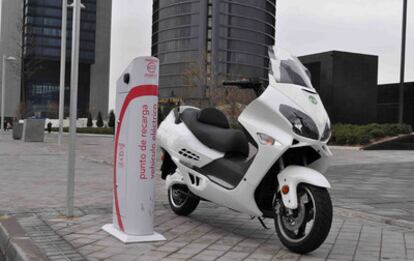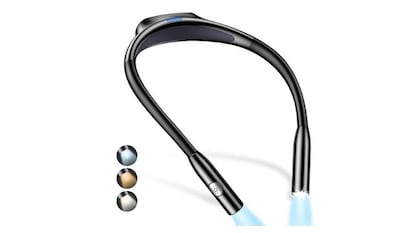A two-wheeled electric solution
Battery-powered scooters offer a new way for sustainable urban transportation
Public transport and bicycles are two obvious solutions to the pollution, rising fuel prices, traffic jams, parking difficulties and other problems associated with urban motoring. But what about electric motor scooters? They charge in a relatively short amount of time (four to five hours); they don't pollute; they hardly make a sound; they have an adequate range; they can reach speeds of 100 km/h; they cost around 60 cents per 100 kilometers to run (seven to 10 times less than their gasoline-powered equivalents); and to drive one, all you need is a regular driver's license.
"It's clear they are not for bikers, but they are already a solution for urban mobility," says Juan Ignacio Iglesias, marketing director at Helectra, a Spanish company that sells three models. And you just have to take a peek at the catalogue of models approved by the Institute for Energy Diversification and Saving (IDAE) to see there are many others available.
The sector is still in its infancy, but it is growing. "The technology is advancing and in a short while it will all advance a lot, from the manufacturers and the recharging points, to things we can't even think of at the moment," says Juan Antonio Alonso, the IDAE's energy saving and efficiency director.
The main questions that get thrown up when talking about electric vehicles usually concern their range, their speed, battery rechargability, and their price.
In terms of range, the 91 models in the IDAE catalogue can travel between 50 and 130 kilometers, more than sufficient for urban use - the trip to and from work, say. What's more, none of the scooters in the catalogue has a top speed below 70 km/h. That said, you should bear in mind that manufacturers' figures are based on performance in ideal conditions and in reality could be lower.
The crux of the matter, though, is recharging the batteries. A complete charge takes around four hours, and in principle, can be done using "any plug you use to charge your cellphone," according to Helectra's Iglesias.
The question becomes more thorny when it comes to recharge points on public highways or in public parking lots. For that, there is the 10-million-euro MOVELE project, which IDAE put in place in spring 2009 with the aim of encouraging 2,000 electric vehicles on to the streets of Madrid, Barcelona and Seville, with a total of 546 recharge points.
According to Sergio Fernández of Fundación Movilidad, which runs MOVELE in Madrid, there are now 246 recharge points in the city - 98 financed by MOVELE, six of which are on the street, and 148, all in parking lots, funded by City Hall.
At present the law does not permit the reselling of electricity, which prevents, for example, a parking garage from charging for a recharge or the setting up of coin-operated parking-meter-style chargers. For now public charge points are free, while shopping mall and hotel parking lots include recharges in general tariffs.
But this is set to change with the creation of recharging agents, which will allow gas stations, kiosks and the like to install points and charge for electricity. Sergio Fernández hopes this will happen in April, but IDAE has not given a date.
The biggest problem with recharging, however, is time. A full charge takes four to five hours - although an 80-percent charge can be done in two hours - compared with five minutes to fill up a car with gasoline, the placing of recharge points next to places of work, motorbike parking spaces and parking lots will be crucial.
Another important issue is price. The most expensive models in the catalogue are priced around 7,000 euros, from which you can take off 15 to 20 percent thanks to MOVELE. A Bereco Voltio Five, for example, costs 4,900 euros, with a 980 euro discount due to the available grant. Unlike electric cars, the price difference between an electric scooter and a normal one isn't excessive. Other subsidies also exist: Madrid City Hall offers a 75-percent discount on road tax, for example. As for fuel costs, traveling 100 kilometers costs just 60 cents, up to 10 times cheaper than a conventional scooter.
Helectra's three models are powered by an engine above the rear wheel. "In reality, it's like a food mixer," says Iglesias. "There is no chain or drive belt, which means there is no wear. It's only the tires and the brakes that will need replacing." A minority of models do have a drive belt.
José Manuel Caramés of Going Green agrees. "Maintenance is minimal, because the electric engines have 90-percent fewer parts than a combustion one. Inspections are annual but basically involve checking that engine parameters are correct." Manufacturers claim that the batteries, normally lithium-ion cells, are good for 2,000 charges and discharge cycles. That means a scooter with a range of 60 kilometers can travel 120,000 kilometers without changing the batteries. You would probably need to change the tires before that.

Tu suscripción se está usando en otro dispositivo
¿Quieres añadir otro usuario a tu suscripción?
Si continúas leyendo en este dispositivo, no se podrá leer en el otro.
FlechaTu suscripción se está usando en otro dispositivo y solo puedes acceder a EL PAÍS desde un dispositivo a la vez.
Si quieres compartir tu cuenta, cambia tu suscripción a la modalidad Premium, así podrás añadir otro usuario. Cada uno accederá con su propia cuenta de email, lo que os permitirá personalizar vuestra experiencia en EL PAÍS.
¿Tienes una suscripción de empresa? Accede aquí para contratar más cuentas.
En el caso de no saber quién está usando tu cuenta, te recomendamos cambiar tu contraseña aquí.
Si decides continuar compartiendo tu cuenta, este mensaje se mostrará en tu dispositivo y en el de la otra persona que está usando tu cuenta de forma indefinida, afectando a tu experiencia de lectura. Puedes consultar aquí los términos y condiciones de la suscripción digital.
Últimas noticias
Manolo González, en la previa del Espanyol - Barcelona: “Lecciones de comportamiento no; recuerden cuando Figo fue al Camp Nou”
Ju-ae, la hija de Kim Jong-un, cada vez más visible en la escenografía del régimen norcoreano
Las nuevas leyes que entrarán en vigor en Florida en 2026
El Ministerio de Transportes defiende que desde 2018 invierte 20 millones semanales en el Corredor Mediterráneo
Lo más visto
- Al menos 40 muertos por un incendio en el bar de una estación de esquí en Suiza
- Los cuatro puentes largos que hay en 2026 y el resto de festivos del calendario laboral
- El vestido de Cristina Pedroche en las Campanadas 2025: un traje hecho con sus anteriores estilismos y en recuerdo a las personas con cáncer
- Nuevas reglas de tráfico para 2026: los conductores que no señalicen con la baliza V16 serán multados
- Sandra Barneda: “Eso de las izquierdas y las derechas es arcaico, un pensamiento que solo sirve para marcar distancias”




























































